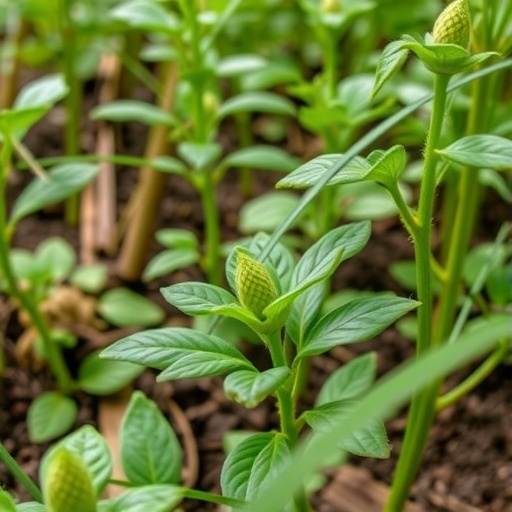In a significant stride towards understanding agricultural biodiversity, a forthcoming study published in Discover Agriculture explores the untapped potential of neglected and underutilized seed crops. These crops, often overshadowed by mainstream agricultural plants, represent a vital resource that holds promise for sustainability, food security, and nutritional diversity. Authors E.M. Wimalasiri, P.W.M. Tharindi, and H. Nayakarathne have conducted a comprehensive bibliometric analysis to elucidate the importance of these crops within the agricultural research landscape.
In recent decades, there has been a growing recognition of the critical role that neglected and underutilized crops can play in diversifying food systems, particularly in the face of climate change and population growth. The research undertaken by Wimalasiri et al. aims to shed light on the scholarly output related to these crops, providing insights into research trends, knowledge gaps, and potential areas for future inquiry. The analysis serves as a call to action for researchers, policymakers, and practitioners to appreciate and invest in these crops that could contribute exponentially to agricultural resilience.
Analyzing data from thousands of research publications, the study employs rigorous bibliometric methodologies to identify key phrases, frequently cited works, and influential authors within the domain. The results highlight not only the breadth of research conducted in this area but also the collaborative networks that span across various countries and institutions. This collaborative spirit is essential in fostering a comprehensive understanding of the challenges and opportunities associated with neglected and underutilized crops.
The authors note that while mainstream crops dominate agricultural research, there is a rich tapestry of lesser-known seeds that can offer unique traits such as drought tolerance, pest resistance, and nutritional benefits. Many of these crops are integral to the food systems of indigenous communities, providing essential sustenance while being deeply entwined with their cultural heritage. The need to revitalize interest in these crops is more pressing than ever, as we witness environmental changes and demand for food shift at an unprecedented pace.
The bibliometric analysis conducted in this research illuminates the historical context of research trends in neglected and underutilized crops. It reveals significant fluctuations in scholarly interest, with periods of intense research activity correlating with global crises such as food shortages and economic downturns. The findings emphasize the cyclical nature of agricultural research prioritization and the importance of maintaining continuous support for diverse crops regardless of immediate pressures.
Notably, the study discusses seed bank initiatives and conservation efforts aimed at preserving the genetic diversity of these crops. Seed banks serve as critical resources for maintaining genetic material that can be cultivated in response to shifting agricultural needs. The authors highlight successful examples of community-led conservation efforts that have revitalized interest in traditional crops, thereby promoting sustainable agricultural practices that respect local ecosystems and knowledge systems.
Sustainability is a central theme in this analysis. By prioritizing neglected and underutilized crops, the agricultural sector has an opportunity to create systems that are less reliant on chemical inputs and monocultures. This transition is essential not only for addressing food insecurity but also for promoting ecological balance and biodiversity. The authors argue that successfully integrating these crops into modern agricultural practices can create a more resilient food system that is better equipped to adapt to the challenges posed by climate change.
Additionally, the researchers address the socio-economic dimensions of reintroducing these crops into mainstream agriculture. They emphasize the importance of engaging local communities through participatory research methods that respect traditional knowledge and practices. This engagement can unlock innovative agricultural practices that draw upon the rich histories of these crops, thereby facilitating their resurgence in contemporary farming systems.
Wimalasiri et al. also point to the role of policy in facilitating the growth of neglected and underutilized seed crops. They call for comprehensive agricultural policies that recognize the value of biodiversity and promote research funding targeting these crops. Collaboration between governments, research institutions, and farmers is pivotal in overcoming barriers that have historically sidelined these resources.
The bibliometric insights presented in the study are underpinned by rich visual data that depicts the interconnectedness of research themes and contributions. These visual representations serve to make complex data more accessible and engaging, thereby enhancing the communicative power of the findings. The authors believe that effective dissemination of their results can foster greater awareness and inspire action among diverse stakeholders involved in food systems.
Looking forward, the researchers outline a roadmap for future studies that could further elucidate the roles and potentials of these neglected crops. They advocate for interdisciplinary approaches that merge agronomy, ecology, and social sciences to comprehensively capture the multifunctionality of these plants. This multifaceted perspective can catalyze the development of new strategies that integrate traditional agricultural wisdom with modern scientific innovations.
This bibliometric analysis is a landmark contribution that not only maps the landscape of research but also serves as a poignant reminder of the need for inclusivity in agricultural research. Wimalasiri, Tharindi, and Nayakarathne urge their colleagues in the scientific community to pivot towards a more holistic understanding of global food systems that champions agricultural diversity. The call is clear: neglected and underutilized seed crops




